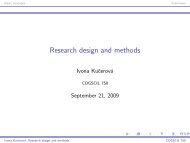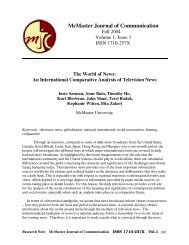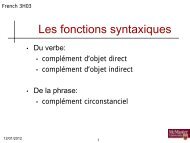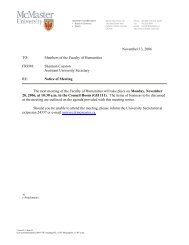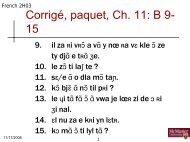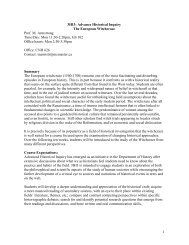The Syntax of Givenness Ivona Kucerová
The Syntax of Givenness Ivona Kucerová
The Syntax of Givenness Ivona Kucerová
Create successful ePaper yourself
Turn your PDF publications into a flip-book with our unique Google optimized e-Paper software.
c. Bylo to myšleno jako útok proti této učitelce<br />
was it though as attack against teacher<br />
‘It was meant as an attack against this teacher.’<br />
Consider now the example in (67). <strong>The</strong> example is <strong>of</strong>fered here as a control showing that<br />
in general there is no problem with having the unmodified form teacher as a continuation<br />
<strong>of</strong> the discourse in (61). Crucially, in this example, G-movement is not required since there<br />
is no new element asymmetrically c-commanding the DP učitelka ‘teacher’.<br />
(67) Učitelka o diskusi (ale) nevěděla.<br />
teacher about discussion but not-knew<br />
‘However, the teacher did not know about the discussion.’<br />
I argue that the reason why the non-modified DP in (62)–(66) is infelicitous as a continuation<br />
<strong>of</strong> the context given in (61) is that the DP needs to be interpreted as given but it is in a<br />
syntactic position from which it cannot undergo G-movement. Since there is no syntactic<br />
operation that could achieve the desired semantic interpretation, inserting an element that<br />
is lexically marked as given is the only option. 26 <strong>The</strong> generalization stating the relation<br />
between pronouns and G-movement is given in (68).<br />
(68) Generalization about syntactic distribution <strong>of</strong> pronouns<br />
If α G is asymmetrically c-commanded by a new element and α G cannot move at<br />
least once, then α G must be lexically given.<br />
<strong>The</strong> above pattern provides an independent argument that G-movement is a last resort operation.<br />
If there is no new element asymmetrically c-commanding α G , α G may be realized<br />
as a full DP even if it is in a position from which it cannot move. It follows that an element<br />
can be interpreted as given even if it does not undergo G-movement. Thus, we can<br />
conclude that the purpose <strong>of</strong> G-movement cannot be to mark or license an element as given<br />
(for example, by checking a G(iven) feature). <strong>The</strong>re must be other tools to interpret an<br />
element as given. In chapter 4 I will argue that the syntax-semantics interface does exactly<br />
that.<br />
If G-movement is a last resort operation, we predict that the restriction on specifiers<br />
observed in (62)–(64) should disappear if the relevant specifier is the highest element in the<br />
structure. As we can see in (69) this is indeed correct.<br />
(69) Učitelovi žáci si totiž stěžovali na jeho učební metody.<br />
teacher’s pupils REFL PART complained at his teaching methods<br />
‘Students <strong>of</strong> the teacher complained about his teaching methods.’<br />
Additional support for the argument that G-movement is a last resort operation comes<br />
from coordinated DPs. If we assume the coordinate structure constraint (Ross, 1967), we<br />
predict that a DP should not be able to move out from a coordination. Thus, a coordinated<br />
given DP should be degraded, unless it is modified by a demonstrative pronoun. As we can<br />
see in (70), this prediction is borne out.<br />
26 Another option would be to choose a structure which allows G-movement to take place.<br />
38





